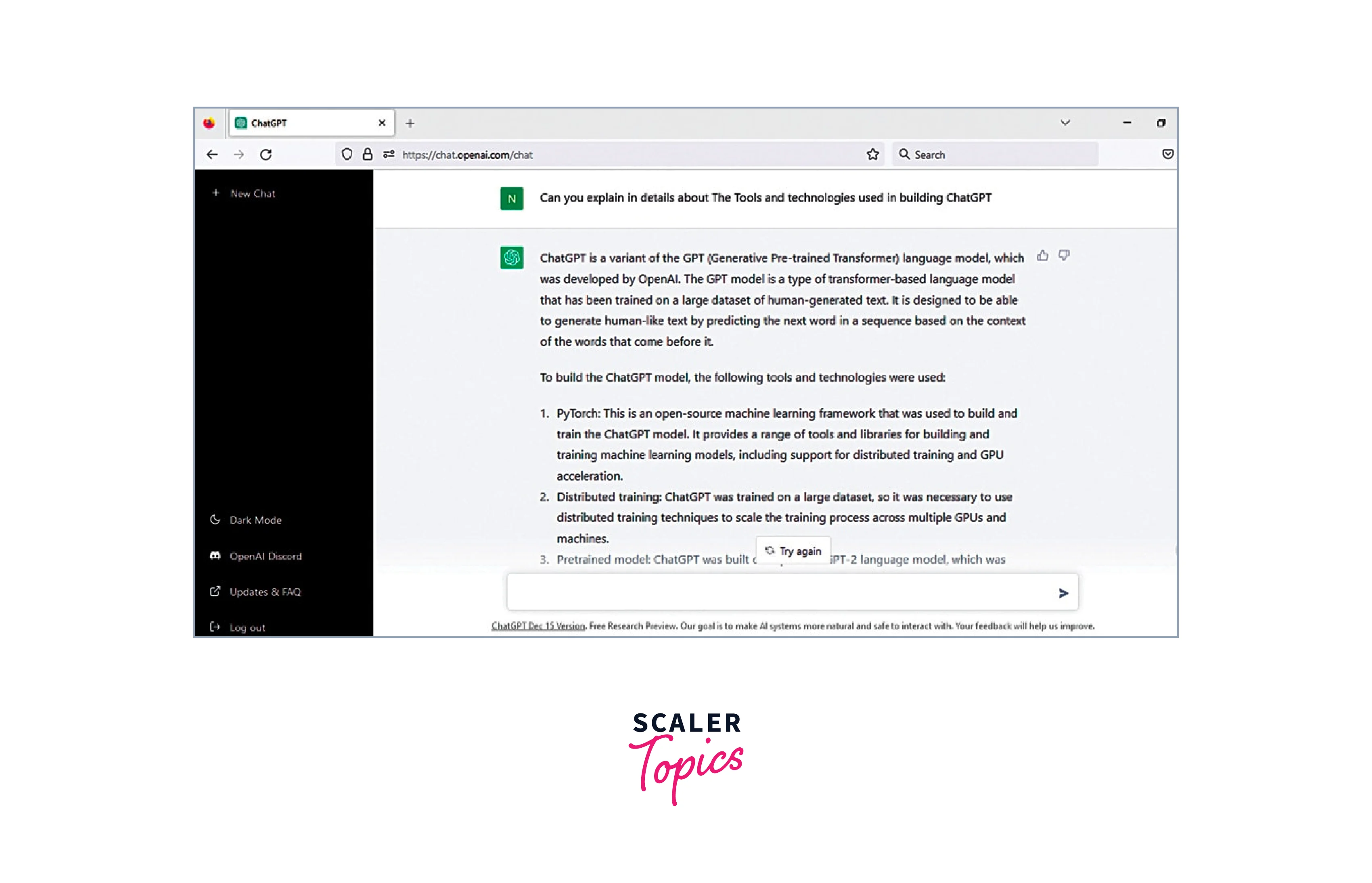Text Generation with GPT Models
Overview
Text generation using GPT models is an exciting and rapidly advancing field in artificial intelligence and natural language processing (NLP). These models, such as OpenAI's GPT-3, are based on deep learning techniques and have demonstrated impressive capabilities in generating human-like text across a wide range of tasks.

Importance of Text Generation
Text generation is valuable in numerous scenarios:
-
Creative Writing:
GPT models can generate creative and coherent stories, poems, and other forms of written content. This can be beneficial in creative writing applications, content creation, and even assisting writers with writer's block. -
Conversational Agents:
Text generation is essential in developing more advanced chatbots and conversational agents. GPT models can respond to user queries, engage in meaningful conversations, and provide helpful information. -
Language Translation:
Text generation models can be used for language translation tasks, where they can convert text from one language to another while maintaining context and semantic coherence. -
Code Generation:
GPT models can also generate code snippets in various programming languages, making them useful for developers seeking assistance or generating code templates. -
Content Summarization:
Text generation models can summarize lengthy articles, news stories, or documents, making it easier for users to get a quick overview of the content. -
Personalization:
These models can be fine-tuned on user-specific data to generate personalized responses, recommendations, or content, enhancing user experience and engagement.
However, it's essential to be cautious with text generation, as these models can sometimes produce misleading or biased information if not properly fine-tuned and supervised.
Preparing Data for Text Generation
High-quality data preparation is crucial for successful text generation with GPT models. Proper data cleaning, formatting, and tokenization are essential steps to ensure the model's optimal performance.
1. Data Cleaning and Formatting
This step involves removing any irrelevant or noisy data, handling missing values, and ensuring the text is properly formatted. Data cleaning typically involves removing special characters, extra whitespaces, and other irrelevant content.
2. Encoding and Tokenization
The text needs to be encoded into a numerical format that can be fed into the GPT model. Tokenization splits the text into smaller units (tokens) for processing.
For encoding and tokenization, we'll use the Hugging Face transformers library, which provides easy-to-use tools for working with GPT models and tokenization.
First, install the required library:
Next, you can use the following Python code for encoding and tokenization:
3. Data Sampling and Balancing
Data sampling and balancing are essential if your dataset is large and imbalanced. Depending on your specific dataset, you might need to perform techniques like random sampling or oversampling/undersampling to balance the data. However, this step is optional and might not be required for every dataset.
For effective text generation, it is essential to balance the training data to avoid biases and improve model performance.
Fine-tuning GPT Models
Fine-tuning GPT models involves taking a pre-trained GPT model and further training it on a specific task or domain using task-specific data. This allows the model to learn task-specific information and improve its performance on the target task.
1. Transfer Learning with GPT Models
Transfer learning with GPT models involves using a pre-trained language model as a starting point for a specific task. In the case of GPT models, transfer learning is achieved by fine-tuning the pre-trained model on task-specific data. The pre-trained GPT model has already learned rich linguistic representations from a large corpus of text, making it a powerful base model for a wide range of natural language processing tasks.
2. Selecting Task-Specific Data
When fine-tuning GPT models, it is crucial to select task-specific data that is relevant to the target task. The data should be representative of the task's domain and cover a diverse range of examples. For instance, if the task is sentiment analysis, the data should include various text samples with different sentiment expressions.
The amount of data available for fine-tuning also plays a significant role. Having a sufficient amount of task-specific data is important for the model to generalize well to new, unseen examples. If task-specific data is limited, techniques like data augmentation can be employed to artificially increase the size and diversity of the training set.
3. Training Process and Hyperparameter Tuning
The training process for fine-tuning GPT models involves taking the pre-trained model and updating its parameters based on the task-specific data. During fine-tuning, the model is presented with task-specific data, and its weights are adjusted through backpropagation to minimize a task-specific loss function. This process allows the model to adapt its learned representations to the particularities of the target task.
Hyperparameter tuning is another critical aspect of the training process. Hyperparameters are configuration settings that determine how the model learns during training. Examples of hyperparameters include the learning rate, batch size, number of training epochs, and dropout rate. Tuning these hyperparameters is essential to finding the right balance between underfitting and overfitting the task-specific data.
During hyperparameter tuning, different combinations of hyperparameter values are tried, and the model's performance is evaluated on a validation set to select the best set of hyperparameters. This process helps ensure that the fine-tuned model achieves optimal performance on the task.
Text Generation Techniques with GPT Models
Text generation with GPT models offers various techniques to control and enhance the generated output.
Importing the necessary classes from the Hugging Face transformers library to work with the GPT-2 model and tokenizer.
Loading the pre-trained GPT-2 model and tokenizer
Let's explore some of the commonly used techniques for text generation:
1. Autoregressive Generation
Autoregressive generation is the standard approach used by GPT models for text generation. In this method, the model generates text token by token, where each token is conditioned on the previously generated tokens. The model samples from its own predicted probability distribution at each step to select the next token. Autoregressive generation allows the model to capture dependencies and context in the generated text.
Output:
2. Conditional Generation
Conditional generation allows you to influence the generated text by providing some initial context or condition. For example, you can give the model a prompt or a starting sentence, and it will continue generating text based on that context. This technique enables you to control the content or style of the generated text more effectively
Output:
3. Prompt Engineering and Control
Prompt engineering involves designing high-quality prompts to steer the model's generation towards desired results. The choice of prompts, along with conditioning techniques, allows developers to control the generated text and ensure it aligns with the intended task.

4. Temperature and Top-k Sampling
Temperature and top-k sampling are techniques used to control the randomness of the generated output. Temperature determines the level of randomness in the model's predictions, while top-k sampling restricts the number of tokens considered during generation, ensuring higher quality and more controlled output.
Output:
Evaluation and Quality Assessment
Evaluating text generation models is a challenging task due to its subjective nature. However, several metrics and evaluation techniques can be employed to assess the quality of generated text.
1. Evaluating Text Coherence and Fluency
Text coherence refers to the logical flow of ideas and smooth transitions between sentences and paragraphs. Fluency, on the other hand, pertains to the naturalness and grammatical correctness of the generated text.
To evaluate text coherence and fluency, you can use human evaluation, BLEU scores, or perplexity.
- BLEU Score:
Although BLEU is mainly used for translation tasks, it can also provide an estimate of fluency by comparing the generated text against human-written reference text. However, BLEU does not directly measure coherence. - Perplexity:
Perplexity can be used as a measure of fluency. Lower perplexity values indicate that the model is more confident in predicting the next token, suggesting better fluency.
2. Measuring Semantic Accuracy and Relevance
Semantic accuracy measures how well the generated text conveys the intended meaning. To evaluate semantic accuracy and relevance, you can use human evaluation, ROUGE scores, or other semantic similarity metrics.
ROUGE Score:
ROUGE can be used to evaluate the relevance of the generated text in comparison to the reference text. It mainly applies to summarization tasks.
3. Addressing Bias and Fairness Concerns
Text generation models, like GPT models, can sometimes produce biased or unfair content. To address bias and fairness concerns, a combination of human evaluation, bias testing datasets, and fairness-aware evaluation is required.
- Bias Testing Datasets:
Specialized datasets containing biased language can be used to evaluate and mitigate model biases. - Fairness-Aware Evaluation:
Metrics such as Equalized Odds and Demographic Parity can be used to assess model fairness for different groups.
Applications of GPT Text Generation
GPT text generation has found numerous applications across various domains due to its ability to generate coherent and contextually relevant text. Some of the more important and impactful applications include:
-
Natural Language Generation (NLG):
GPT text generation is widely used in Natural Language Generation applications, such as chatbots, virtual assistants, and automated content creation. NLG models can produce human-like responses and generate contextually relevant text based on user input. -
Text Summarization:
GPT-based models are used for text summarization tasks, where they can condense lengthy documents or articles into concise and coherent summaries. Text summarization is valuable for information retrieval and content comprehension. -
Code Generation and Autocompletion:
GPT models can assist developers in programming tasks by generating code snippets or providing code autocompletion suggestions. This aids in writing code more efficiently and accurately. -
Language Translation:
GPT text generation is applied to machine translation tasks, enabling the conversion of text from one language to another. Language translation models help bridge communication gaps in multilingual contexts. -
Question-Answering Systems:
GPT models can be adapted for question-answering systems, where they can generate answers to specific queries based on context. This is beneficial for information retrieval and user assistance.
Conclusion
- Text generation with GPT models has opened new frontiers in NLP, enabling applications that were once considered challenging.
- By leveraging pre-trained models and fine-tuning them on task-specific data, developers can harness the power of GPT-3 to generate coherent and contextually relevant text for a wide range of applications.
- As the field of text generation continues to evolve, advancements in evaluation techniques and addressing bias concerns will further enhance the quality and utility of GPT-generated text, making it an indispensable tool for various industries and domains.
